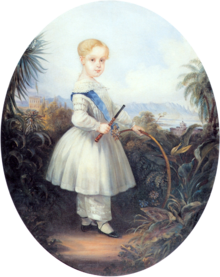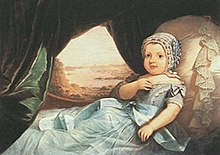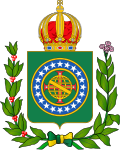Afonso, Prince Imperial of Brazil
| Afonso | |||||
|---|---|---|---|---|---|
| Prince Imperial of Brazil | |||||
 Afonso at age 2 wearing the blue band of the Order of the Southern Cross, 1846 | |||||
| Born | 23 February 1845 Palace of São Cristóvão, Rio de Janeiro, Brazil | ||||
| Died | 11 June 1847 (2 years, 108 days) Palace of São Cristóvão, Rio de Janeiro, Brazil | ||||
| Burial | Convento de Santo Antônio (Convent of Saint Anthony), Rio de Janeiro, Brazil | ||||
| |||||
| House | House of Braganza | ||||
| Father | Pedro II of Brazil | ||||
| Mother | Teresa Cristina of the Two Sicilies | ||||
| Religion | Roman Catholicism | ||||
Dom Afonso (23 February 1845 – 11 June 1847) was the Prince Imperial and heir apparent to the throne of the Empire of Brazil. Born in Rio de Janeiro, he was the eldest child of Emperor Dom Pedro II and Dona Teresa Cristina of the Two Sicilies, and thus a member of the Brazilian branch of the House of Braganza. With the birth of his child, the insecure and shy 19-year-old Emperor Pedro II became more mature and outgoing. Afonso's arrival also fostered a closer and happier relationship between his parents, who had not married for love.
Afonso died from epilepsy at the age of two, devastating the emperor. After the subsequent loss of his other son, doubts grew in Pedro II's mind that the imperial system could be viable. He still had an heir in his daughter Isabel, but he was unconvinced that a female would prove to be a suitable successor. He became careless about the effects of his policies on the monarchy, provided his daughter Isabel with no training for her role as potential empress, and failed to cultivate her acceptance within the country's political class. Pedro II's disinterest in protecting the imperial system ultimately led to its downfall.
Infancy
Birth

Afonso was born on 23 February 1845 in the Palace of São Cristóvão, in Rio de Janeiro, Brazil.[1] His full name was Afonso Pedro de Alcântara Cristiano Leopoldo Filipe Eugênio Miguel Gabriel Rafael Gonzaga.[1]
Through his father, Emperor Pedro II, he was a member of the Brazilian branch of the House of Braganza (Portuguese: Bragança) and was referred to using the honorific "Dom" (Lord) from birth.[2] Afonso was the grandson of Emperor Pedro I of Brazil and nephew of Queen Maria II of Portugal.[A] Through his mother, Teresa Cristina, he was a grandson of Francesco I (Francis I) and nephew to Ferdinando II (Ferdinand II), who ruled as kings of the Two Sicilies in turn.[B]
As was customary within the House of Braganza, Afonso's birth was a formal event attended by the royal court.[3] Pedro II immediately presented the new born baby to the throng gathered in the palace, announcing "Gentlemen, here is a Prince whom God ..."—here he was overcome with emotion and was unable to continue.[4][5] Luís Alves de Lima e Silva (then Baron and later Duke of Caxias) wrote to his father: "No one was happier than I with the news [of the prince's birth]".[6]
Afonso was healthy, and as the eldest son of Pedro II, was heir to the throne and styled "Prince Imperial".[4][5] The young prince resembled his father, particularly in his face, hair and eyes.[7] Because of his gender and position as heir apparent, he became the center of attention, particularly for Pedro II.[8] A letter written by Pedro II to his elder sister Maria II a few months after the birth of his second child—a daughter named Isabel—displayed his happiness: "No news here save the good state of health of myself, of the empress, and of the little ones, who are becoming increasingly cute, principally little Afonso, who is already walking and who says many words, still half incomprehensible, which increases their charm."[9]
Impact of his birth on Pedro II

Emperor at the age of 5 and declared of age and fit to begin ruling at 14, Pedro II had been an awkward and shy adolescent, suspicious of everyone around him. He was thrust into a thankless and burdensome role as the national symbol for a country that had almost disintegrated during his childhood, wracked by a long series of widespread provincial rebellions. The death of his parents and his sister Paula during his childhood had created in Pedro II a fear of abandonment and a terror of becoming attached to anyone. The birth of his first son gave him a sense of purpose and belonging that had long been missing.[10]
"Fatherhood", said historian Roderick J. Barman, "gave the emperor the emotional security and the self-confidence so conspicuously missing during his childhood and adolescence."[10] Pedro II found it easier to break out of his social isolation, and he became more open, impartial, and polite.[11] His new confidence and openness allowed him to establish his authority as monarch and take "full control of his life and of the government".[11] Parenthood also produced a marked improvement in his relationship with his wife, Teresa Cristina, whom he had only married in the interests of the empire. The marriage thereafter became a happy one, aided by her faithful dedication, his development of a more stable and mature character, and their growing mutual domestic interests and affection.[12]
Early death and aftermath
Death

On 11 June 1847, the young prince was playing in the library of the palace when he experienced a series of strong convulsions and died, not quite two and a half years old.[13] His death revealed that Afonso suffered from epilepsy, as did his father.[14]
The grief of Pedro II and his wife was enormous. It was feared that the shock might affect Teresa Cristina's health, as she was pregnant at the time with her third child. She later gave birth without complications on 13 July to a girl, who was christened Leopoldina.[8] The devastated emperor wrote a letter to his stepmother, the Empress Amélia, dated 11 July 1847, telling her of Afonso's death: "With the most piercing grief I tell you that my little Afonso, your godson, unfortunately died of convulsions, which he suffered during five hours on the 4th of last month;[C] and a few days ago little Isabel was put at risk by a strong attack of convulsions that greatly frightened me."[8]
A grand state funeral—not seen since the death of Pedro II's sister Paula in 1833—was held for the Prince Imperial at 7 p.m. three days after his death.[13] He is buried alongside other members of the Brazilian House of Braganza (including his younger brother Pedro, his uncle João and his aunt Paula) in the mausoleum of the Convento de Santo Antônio (Convent of Saint Anthony) in Rio de Janeiro.[13]
Legacy
The prince's early death (and the later demise of his younger brother) had an enormous impact on Pedro II: on a personal level, on his future conduct as monarch, and on the empire. In his eyes, the deaths of his only sons seemed to presage the end of the imperial system. Although the emperor still had a legal successor in his daughter Isabel, in the male-dominated society of the time he had little confidence that a woman could rule Brazil. He was fond and respectful of the women in his life, but he did not consider it feasible that Isabel could survive as monarch. He did nothing to prepare Isabel for the responsibilities of ascending the throne, nor did he attempt to encourage acceptance of a female ruler among the political class or in the wider public.[15]
Pedro II began his rule as a figurehead who held together a realm on the verge of disintegration. He quickly matured and successfully navigated the empire through repeated and serious crises. By the time of Afonso's death, the nation was entering an unprecedented era of prosperity, development and tranquility. Even as the emperor's political successes and policies began to bear fruit, the lack of a male heir caused him to lose motivation to promote the imperial office as a position to be carried on by his descendants. The emperor turned away from personal and family ties, and focused on upholding the constitution while directing Brazil toward policies that furthered modernization and social advancement. The future of the monarchy as an institution no longer mattered to him, and in 1889, he was deposed in a coup, marking the end of the Empire of Brazil.[16]
Titles, styles
Titles and styles
- 23 February 1845 – 11 June 1847: His Imperial Highness The Prince Imperial
The prince's full style and title was "His Imperial Highness Dom Afonso, Prince Imperial of Brazil".[D]
Honors
Prince Afonso was a recipient of the following Brazilian Orders:
- Major Commander of the Order of Christ[17]
- Major Commander of the Order of Saint Benedict of Aviz[17]
- Major Commander of the Order of Saint James of the Sword[17]
- Grand Cross of the Order of Pedro I[18]
- Grand Cross and Grand Major Dignitary of the Order of the Rose[18]
Ancestry
Endnotes
- ^ Pedro I and Maria II were Pedro II's father and sister, respectively.[19]
- ^ Francesco I and Ferdinando II were Teresa Cristina's father and brother.[20]
- ^ Pedro II was mistaken about the date of his son's death. It did in fact occur on 11 June.[21]
- ^ Article 105 of the Brazilian Constitution of 1824 states: "The presumptive heir of the Empire will have the title of—Prince Imperial ... The style of the presumptive heir will be—Imperial Highness".[22]
Footnotes
- ^ a b Laemmert 1847, p. 35.
- ^ Barman 1999, p. 424.
- ^ Barman 1999, p. 110.
- ^ a b Calmon 1975, p. 274.
- ^ a b Lyra 1977, p. 139.
- ^ Calmon 1975, p. 276.
- ^ Diener and Costa 2002, p. 79.
- ^ a b c Barman 2002, p. 24.
- ^ Barman 2002, pp. 23–24.
- ^ a b Barman 1999, p. 111.
- ^ a b Barman 1999, p. 109.
- ^ Barman 1999, p. 126.
- ^ a b c Calmon 1975, p. 317.
- ^ Barman 1999, p. 48.
- ^ Barman 1999, pp. 129–130.
- ^ Barman 1999, p. 130.
- ^ a b c Laemmert 1849, p. 26.
- ^ a b Laemmert 1849, p. 24.
- ^ Schwarcz 1998, p. 47.
- ^ Calmon 1975, p. 210.
- ^ Barman 2002, p. 252.
- ^ Rodrigues 1863, p. 95.
References
- Barman, Roderick J. (1999). Citizen Emperor: Pedro II and the Making of Brazil, 1825–1891. Stanford, California: Stanford University Press. ISBN 0-8047-3510-7.
{{cite book}}: CS1 maint: ref duplicates default (link) - Barman, Roderick J. (2002). Princess Isabel of Brazil: gender and power in the nineteenth century. Wilmington, Delaware: Scholarly Resources. ISBN 0-8420-2846-3.
{{cite book}}: CS1 maint: ref duplicates default (link) - Calmon, Pedro (1975). História de D. Pedro II (in Portuguese). Vol. 5. Rio de Janeiro: J. Olympio.
{{cite book}}: CS1 maint: ref duplicates default (link) - Diener, Pablo; Costa, Maria de Fátima (2002). Rugendas e o Brasil (in Portuguese). São Paulo: Capivara. ISBN 85-89063-08-9.
- Lyra, Heitor (1977). História de Dom Pedro II (1825–1891): Ascenção (1825–1870) (in Portuguese). Vol. 1. Belo Horizonte: Itatiaia.
{{cite book}}: CS1 maint: ref duplicates default (link) - Laemmert, Eduardo (1847). Almanak Administrativo, Mercantil e Industrial (Almanaque Laemmert) (in Portuguese). Rio de Janeiro: Eduardo e Henrique Laemmert & C.
{{cite book}}: CS1 maint: ref duplicates default (link) - Laemmert, Eduardo (1849). Almanak Administrativo, Mercantil e Industrial (Almanaque Laemmert) (in Portuguese). Rio de Janeiro: Eduardo e Henrique Laemmert & C.
{{cite book}}: CS1 maint: ref duplicates default (link) - Rodrigues, José Carlos (1863). Constituição política do Império do Brasil (in Portuguese). Rio de Janeiro: Typographia Universal de Laemmert.
{{cite book}}: CS1 maint: ref duplicates default (link) - Schwarcz, Lilia Moritz (1998). As barbas do Imperador: D. Pedro II, um monarca nos trópicos (in Portuguese) (2 ed.). São Paulo: Companhia das Letras. ISBN 85-7164-837-9.
{{cite book}}: CS1 maint: ref duplicates default (link)
External links
![]() Media related to Afonso, Prince Imperial of Brazil at Wikimedia Commons
Media related to Afonso, Prince Imperial of Brazil at Wikimedia Commons

